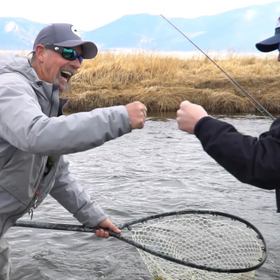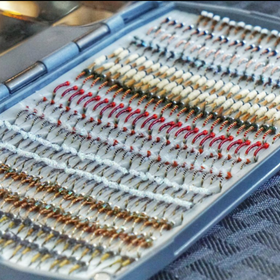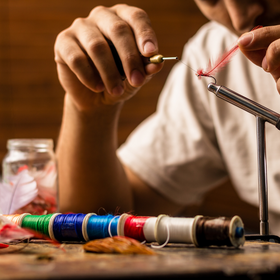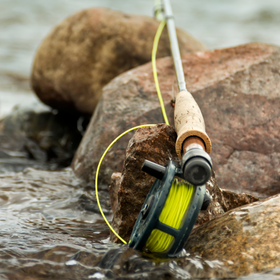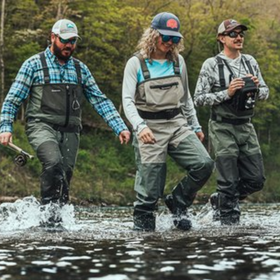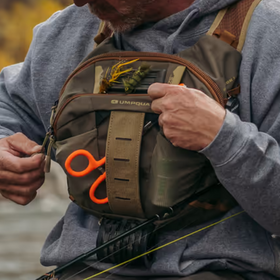Swinging With Rick
By Richard Magill
After moving from Montana about a year ago, I haven't been able to throw any of my trout spey rods due to the size of the fisheries I have been targeting. That all changed one day at the fly shop when one of our float guides picked up some streamers. He kindly invited me and another employee, Ben, to go on a streamer float down the famed Colorado River, and of course we jumped at the opportunity. Stripping streamers all day, we absolutely crushed it. One of the most fun streamer days I've ever had, with the bonus of discovering the Colorado River is tailor-made for throwing a trout spey set up. The thought of throwing my spey rod on the Colorado kept creeping into the back of my mind. It was only a matter of time before I would find myself knee-deep in its waters.
Almost a month passed before I could return to the Colorado and test my theory that a swung fly would produce. I used an old Sage One 11' 3wt rod paired with Sage's Trout Spey reel in a 3/4/5 size. The reel balances the rod perfectly and features a full-frame design to prevent small-diameter shooting lines from traveling between the spool and the frame. A modern equivalent for the rod I was using is the Sage Trout Spey HD 11’ 3wt. Incredible rods to say the least.
Anglers can choose from the two main types of shooting heads when throwing a spey rod: Scandinavian heads and Skagit heads. Scandinavian or Scandi heads are longer and provide a more delicate presentation. They are generally used with a tapered nylon leader the same length as the rod being fished and are the best shooting head when throwing soft hackles or skating big dry flies on the surface. Skagit heads are much shorter and have a thicker diameter to aid in sticking to the water's surface when loading the rod before a cast. They also require the use of a sink tip. RIO makes the best sink tips for this purpose. They are called MOW Tips, which are triple-density tungsten-impregnated tips that come in different sink rates for varying applications. Skagit heads are ideal when throwing streamers or any larger flies.

Throwing streamers all day I was utilizing RIO’s 2/3wt Skagit Mini Max Power, and one of their 3D MOW tips in I/S3/S4. The head is a 250 grain 17’ floating head. I used RIO’s 35LB Slick Shooter, a hard nylon that is great for casting long distances.
With my setup dialed in, I woke up around 4 am and started brewing coffee. A French press is my preferred method when preparing for a cold fall morning.
While the coffee was brewing, I woke up my buddy, who was visiting from Chicago. We go way back, with fishing and sailing being the main activities when hanging out. I had taken him to the Dream Stream the day before, waking up at 3:30 to get there before the sun was out. My favorite time to rig. We fished hard until noon, managing a few fish on streamers before the place was inundated with fellow anglers trying their hand at the 75 cfs coursing between Spinney and 11-mile reservoirs. As we were leaving, he asked me where we would fish the next day. That's when it hit me. The &%$#ing Colorado! We are going to swing flies!
The following day, Ben is finally awake, and we are both slugging our first cup of coffee, trying to maintain focus while gathering the last of the day's supplies. The car was packed with several 6wts, a 5wt, and most importantly, my 11' 3wt Sage One. It's hands-down my favorite fly rod. It has caught more monster brown and rainbow trout than any other tool in my arsenal, and now I was getting to swing it on one of Colorado's most iconic rivers.
We hit the road with a fresh cup of coffee in hand, jamming out to a mix of old-school hip hop and Widespread Panic. A solid combo that is sure to get any angler in the suitable mental space before slaying tanks all day.
One hour and fifty-six minutes later, we had finally arrived at the parking lot. The air temp was a brisk 23 degrees Fahrenheit with no wind. The river was flowing just over 1,000 cfs and hovering around 51 degrees. It didn't take long to wader up and plunge into the river. Ben got in the water upriver about 200 feet or so from where I was entering and caught his first fish of the day almost immediately, casting one of Rio's Lysergic Perch and stripping it back. He was stoked, as was I. First fish of the day!
It took a bit longer for me to find my first fish. I started off fishing a small leach pattern and only managed a few plucky grabs. I decided to change my fly to a small sculpin fly I tied. It was tied weightless on a B-10s, so it would have a ton of action when fished on an aggressive sink tip. The move paid off almost immediately. A nice brown smashed the fly mid-swing. It had been far too long since I had last felt a trout try and kill something attached to my spey rod, and I couldn't be happier that it had happened. Catching trout on a swung fly is one of the purest forms of joy I've experienced, and for the rest of the day, Ben and I would continue catching angry brown and rainbow trout. I even managed to catch a nice sucker, though it was foul-hooked.

Now that I know of viable swing runs in Colorado, I will certainly spend more time knee-deep swinging flies. 2024 is the year of Colorado Trout Spey. Spring can't come soon enough.
If you have any questions about the casting techniques or gear, feel free to swing by the shop. We'll gladly help to get you dialed and on the water.


